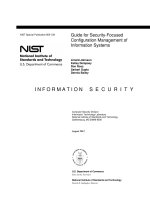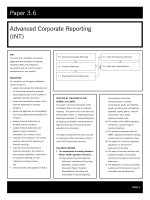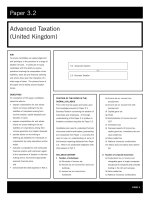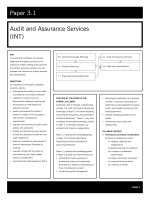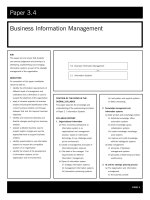acca test book Information Systems pot
Bạn đang xem bản rút gọn của tài liệu. Xem và tải ngay bản đầy đủ của tài liệu tại đây (357.38 KB, 8 trang )
PAGE 3
PAGE 3
AIM
To develop a knowledge and understanding
of information systems development and
delivery as required to take an informed
and active role in information systems
solutions.
OBJECTIVES
On completion of this paper candidates
should be able to:
• explain how to effectively use
information systems and information
systems resources in an organisation
• identify and apply methods of
organising and accounting for
information systems delivery and
information systems projects
• explain the principles of initiating,
planning and controlling information
systems projects
• participate in the definition and
specification of user and system
requirements
• describe how an appropriate solution
might be defined to fulfil the specified
user requirements
• participate in the implementation,
monitoring and maintenance of an
information systems solution
• participate in the quality assurance of
an information systems project
• identify how computer software can
assist effective information systems
management, development and quality
assurance.
POSITION OF THE PAPER IN THE
OVERALL SYLLABUS
The paper assumes a familiarity with the
basic applications of information technology.
The paper provides the knowledge and
understanding of information systems
required to enable the candidate to
progress to the more strategic perspectives
considered in Paper 3.4 Business
Information Management.
The ideas introduced in this paper are also
drawn upon in Paper 2.6 Audit and Internal
Review, Paper 3.1 Audit and Assurance
Services and Paper 3.5 Strategic Planning
and Development.
SYLLABUS CONTENT
1 Managing information systems (IS)
(a) Business strategy and IS/IT alignment.
(b) Delivering information systems –
organisational arrangements.
(c) Delivering information systems –
accounting issues.
(d) Organising information systems –
structural issues.
(e) Feasibility study.
(f) Project initiation.
(g) Project planning.
(h) Project monitoring and control.
(i) Software support for project
management.
2 Designing information systems
(a) The information systems
development process.
(b) Investigating and recording user
requirements.
(c) Documenting and modelling user
requirements – processes.
(d) Documenting and modelling user
requirements – static structures.
(e) Documenting and modelling user
requirements – events.
(f) External design.
(g) Developing a solution to fulfil
requirements.
(h) Software package selection.
Information Systems
Paper 2.1
3.4 Business Information Management
2.1 Information Systems
PAGE 4
(i) Software support for the systems
development process.
3 Evaluating information systems
(a) Technical information systems
requirements.
(b) Legal compliance in information
systems.
(c) Implementing security and legal
requirements.
(d) Quality assurance in the management
and development process.
(e) Systems and user acceptance testing.
(f) Implementation issues and
implementation methods.
(g) Post-implementation issues.
(h) Change control in systems
development and maintenance.
(i) Relationship of management,
development process and quality.
EXCLUDED TOPICS
Detailed systems design – file / database
design, program design is an excluded
topic. Computer hardware will not be
explicitly examined.
KEY AREAS OF THE SYLLABUS
The syllabus has three key areas, managing
information systems, designing information
systems and evaluating information systems.
APPROACH TO EXAMINING THE
SYLLABUS
The examination is a three hour paper
constructed in two sections. Section A is
based on a short narrative scenario. This
section will have three compulsory
questions from across the syllabus, linked
to the narrative scenario. Each question
will be worth 20 marks giving a total of 60
marks for this section.
Section B contains three independent
questions, one question from each main
area of the syllabus. Each question is
worth 20 marks. The candidate must
answer two questions giving a total of 40
marks for this section.
Number
of marks
Section A: 3 compulsory questions
(20 marks each) 60
Section B: Choice of 2 from 3
questions (20 marks each) 40
100
ADDITIONAL INFORMATION
The Study Guide and Exam Notes provide
more detailed guidance on the syllabus,
particularly with respect to acceptable
approaches to modelling
RELEVANT TEXTS
There are a number of sources from which
you can obtain a series of materials written
for the ACCA examinations. These are
listed below:
Foulks Lynch – ACCA's official publisher
Contact number: +44 (0)20 8831 9990.
Website: www.foulkslynch.com
Information Systems (Continued)
Accountancy Tuition Centre (ATC)
International
Contact number: +44 (0)141 880 6469.
Website: www.ptc-global.com
BPP
Contact number: +44 (0)20 8740 2211.
Website: www.bpp.com
The Financial Training Company
Contact number: +44 (0)17 4785 4302.
Website: www.financial-training.com
Candidates may also find the following
texts useful:
Don Yeates and James Cadle Project
Management for Information Systems
(2nd Edition) Pitman Publishing
ISBN 0273620193
Steve Skidmore and Malcolm Eva
Introducing Systems Development
Palgrave Macmillan
ISBN 0333973690
Looking specifically at each area of the
paper:
MANAGING INFORMATION SYSTEMS
Don Yeates and James Cadle Project
Management for Information Systems
Pitman Publishing
ISBN 0273620193
Relevant chapters 2,3, 5-11 & 13
PAGE 5
Continuum International Publishing 2002
DESIGNING INFORMATION SYSTEMS
Steve Skidmore and Malcolm Eva
Introducing Systems Development
Palgrave Macmillan 2003
ISBN 0333721411
Relevant chapters 5-9
Don Yeates and James Cadle Project
Management for Information Systems
Pitman Publishing 1996
Relevant chapters 2-3
Supporting texts
Ken Lunn Software Development with
UML Palgrave Macmillan 2003
Simon Bennett, Steve McRobb, Ray Farmer
Object-Oriented Systems Analysis and
Design McGraw-Hill 2001
Information Systems (Continued)
EVALUATING INFORMATION SYSTEMS
Steve Skidmore and Malcolm Eva
Introducing Systems Development
Palgrave Macmillan 2003
Relevant chapters 11-15
Don Yeates and James Cadle Project
Management for Information Systems
Pitman Publishing 1996
Relevant chapter 12
Supporting texts
David Bainbridge Introduction to Computer
Law Longman 1999
Cem Kaner, Jack Falk and Hung Quoc
Nguyen Testing Computer Software Von
Nostrand Reinhold 1994
Wider reading is also desirable, especially
regular study of relevant articles in ACCA's
student accountant.
STUDY SESSIONS
PART 1: MANAGING INFORMATION
SYSTEMS
Overall
This section provides the candidate with an
insight into how information systems (IS)
and information systems projects are
organised and managed. The intention is to
concentrate on the following areas.
• Information Systems strategy,
organisation and financing
• Project Management
1 Business strategy and IS/IT alignment
(a) Explain an approach that an
organisation may follow to formulate
its strategic business objectives.
(b) Discuss how information systems
may be used to assist in achieving
these objectives.
(c) Identify current trends in information
technology (IT) and the opportunities
they offer to organisations.
(d) Distinguish between a business
strategy and an information systems
strategy.
(e) Identify responsibility for the
ownership of the IS strategy.
2 Delivering information systems –
organisational arrangements
(a) Describe the traditional structure of
a centralised Information Systems
department and the roles and
responsibilities of each function.
Steve Skidmore and Malcolm Eva
Introducing Systems Development
Palgrave Macmillan 2003
ISBN 0333721411
Relevant chapters 1-4 & 10
Supporting texts
Colin Bentley Practical PRINCE2
The Stationary Office 2002
Terry Lucey Quantitative Techniques
PAGE 6
(b) Explain the principles of a
decentralised Information Systems
function.
(c) Discuss the advantages and
disadvantages of centralising or
decentralising the information
systems function.
(d) Explain the principles of outsourcing
the information systems function.
(e) Describe the advantages and
disadvantages of outsourcing the
information systems function.
3 Delivering information systems –
accounting issues
(a) Briefly describe the types of cost
incurred in delivering information
systems.
(b) Describe how the costs of the
information systems function may be
distributed between customer
departments.
(c) Explain the principles, benefits and
drawbacks of cross-charging costs.
(d) Discuss the issues raised by
establishing the information systems
function as a cost or profit centre.
(e) Describe the advantages and
disadvantages of establishing the
information systems function as a
separate company.
(f) Explain the problems of accounting
for shared infrastructure costs.
4 Organising information systems –
structural issues
(a) Describe the typical hardware,
software, data and communications
infrastructures found within
information systems functions.
(b) Discuss the meaning and need for a
disaster recovery plan.
(c) Discuss the meaning and need for a
risk management process.
(d) Describe the meaning and
implications of legacy systems.
(e) Discuss the relationship of
information systems with end-users
and the implications of the
expectations and skills of end-users.
5 Feasibility study
(a) Explain the purpose and objectives
of a feasibility study.
(b) Evaluate the technical, operational,
social and economic feasibility of the
proposed project.
(c) Describe and categorise the benefits
and costs of the proposed project.
(d) Apply appropriate investment
appraisal techniques to determine
the economic feasibility of a project.
(e) Define the typical content and
structure of a feasibility study report.
6 Project initiation
(a) Define the content and structure of
terms of reference.
(b) Describe the typical contents of a
Project Quality Plan and explain the
need for such a plan.
(c) Identify the roles and responsibilities
of staff who will manage and
participate in the project.
(d) Define in detail the role and
responsibilities of the project manager.
(e) Explain the concept of a flat
management structure and its
application to project-based systems
development.
7 Project planning
(a) Assist in splitting the project into its
main phases.
(b) Participate in the breakdown of work
into lower-level tasks.
(c) Assist in the estimation of the time
taken to complete these lower-level
tasks.
(d) Define dependencies between lower-
level tasks.
(e) Construct and interpret a project
network.
(f) Construct and interpret a Gantt Chart.
8 Project monitoring and control
(a) Describe methods of monitoring and
reporting progress.
(b) Define the reasons for slippage and
how to deal with slippage when it
occurs.
(c) Discuss the reasons for changes
during the project and the need for a
project change procedure.
(d) Identify the effects of progress,
slippage and change requests on the
project plan.
Information Systems (Continued)
PAGE 7
(e) Discuss the particular problems of
planning and controlling information
systems projects.
9 Software support for project
management
(a) Define the meaning of a project
management software package and
give a brief list of representative
products.
(b) Describe a range of features and
functions that a project management
software package may provide.
(c) Explain the advantages of using a
project management software
package in the project management
process.
PART 2: DESIGNING INFORMATION
SYSTEMS
Overall
This section provides the candidate with an
insight into how systems are defined and
developed. The intention is to concentrate
on the following areas.
• The definition and agreement of
business requirements
• The external design of the system
• The selection of a software package
solution
10 The information systems development
process
(a) Define the participants in the
systems development process –
managers, analysts, designers,
programmers and testers.
(b) Describe the waterfall approach to
systems development and identify its
application in a representative
systems development methodology.
(c) Describe the spiral approach to
systems development and identify its
application in a representative
systems development methodology.
(d) Discuss the relative merits of the
waterfall and spiral approaches,
including an understanding of hybrid
methodologies that include elements
of both.
11 Investigating and recording user
requirements
(a) Define the tasks of planning,
undertaking and documenting a user
interview.
(b) Identify the potential role of
background research, questionnaires
and special purpose surveys in the
definition of requirements.
(c) Describe the purpose, conduct and
recording of a facilitated user
workshop.
(d) Explain the potential use of
prototyping in requirement’s
definition.
(e) Explain how requirements can be
collected from current computerised
information systems.
(f) Discuss the problems users have in
defining, agreeing and prioritising
requirements.
12 Documenting and modelling user
requirements – processes
(a) Describe the need for building a
business process model of user
requirements.
(b) Describe in detail the notation of
either a data flow diagram or a
flowchart.
(c) Construct a business process model
of narrative user requirements using
a data flow diagram or a flowchart.
(d) Explain the role of process models in
the systems development process.
13 Documenting and modelling user
requirements – static structures
(a) Describe the need for building a
business structure model of user
requirements.
(b) Describe in detail the notation of
either an entity-relationship model
(Logical Data Model) or a class
model.
(c) Construct a business structure model
of narrative user requirements using
an entity-relationship model (Logical
Data Model) or a class model.
(d) Explain the role of structure models
in the systems development process.
14 Documenting and modelling user
requirements – events
(a) Describe the need for building a
business event model of user
requirements.
Information Systems (Continued)
PAGE 8
be structured for ease of use.
(h) Explain how prototyping may be
used in defining an external design.
16 Developing a solution to fulfil
requirements
(a) Define the bespoke software
approach to fulfilling the user’s
information systems requirements.
(b) Briefly describe the tasks of design,
programming and testing required in
developing a bespoke systems solution.
(c) Define the application software
package approach to fulfilling the
user’s information systems
requirements.
(d) Briefly describe the tasks of package
selection, evaluation and testing
required in selecting an appropriate
application software package.
(e) Describe the relative merits of the
bespoke systems development and
application software package
approaches to fulfilling an
information systems requirement.
17 Software package selection
(a) Describe the structure and contents
of an Invitation to Tender (ITT).
(b) Describe how to identify software
packages and their suppliers that
may potentially fulfil the information
systems requirements.
(c) Develop suitable procedures for
distributing an ITT and dealing with
subsequent enquiries and bids.
(d) Describe a process for evaluating the
application software package, the
supplier of that package and the bid
received from the supplier.
(e) Describe risks of the application
software package approach to
systems development and how these
might be reduced or removed.
18 Software support for the systems
development process
(a) Define a Computer Aided Software
Engineering (CASE) tool and give a
brief list of representative products.
(b) Describe a range of features and
functions that a CASE tool may
provide.
(c) Explain the advantages of using a
CASE tool in the systems
development process.
(d) Define a Fourth Generation
Language and give a brief list of
representative products.
(e) Describe a range of features and
functions that a Fourth Generation
Language may provide.
(f) Explain how a Fourth Generation
Language contributes to the
prototyping process.
PART 3: EVALUATING INFORMATION
SYSTEMS
Overall
This section provides the candidate with an
insight into how systems are implemented
and evaluated. The intention is to
concentrate on the following areas.
• The definition and agreement of non-
business requirements
• The quality assurance of the solution
• The implementation and maintenance
of the solution.
19 Technical information systems
requirements
(a) Define and record performance and
volume requirements of information
systems.
Information Systems (Continued)
(b) Describe in detail the notation of
either a statechart diagram (state
transition diagram) or an entity life
history.
(c) Construct a business event model of
narrative user requirements using a
statechart diagram (state transition
diagram) or an entity life history.
(d) Explain the role of event models in
the systems development process.
15 External design
(a) Define the characteristics of a “user-
friendly” system.
(b) Describe the task of external design
and distinguish it from internal design.
(c) Design effective output documents
and reports.
(d) Select appropriate technology to
support the output design.
(e) Design effective inputs.
(f) Select appropriate technology to
support input design.
(g) Describe how the user interface may
PAGE 9
(b) Discuss the need for archiving,
backup and restore, and other
“house-keeping” functions.
(c) Explain the need for a software audit
trail and define the content of such a
trail.
(d) Examine the need to provide
interfaces with other systems and
discuss the implications of
developing these interfaces.
(e) Establish requirements for data
conversion and data creation.
20 Legal compliance in information systems
(a) Describe the principles, terms and
coverage typified by the UK Data
Protection Act.
(b) Describe the principles, terms and
coverage typified by the UK
Computer Misuse Act.
(c) Explain the implications of software
licences and copyright law in
computer systems development.
(d) Discuss the legal implications of
software supply with particular
reference to ownership, liability and
damages.
21 Implementing security and legal
requirements
(a) Describe methods to ensure the
physical security of IT systems.
(b) Discuss the role, implementation
and maintenance of a password
system.
(c) Explain representative clerical and
software controls that should assist
in maintaining the integrity of a
system.
(d) Describe the principles and
application of encryption techniques.
(e) Discuss the implications of software
viruses and malpractice.
(f) Discuss how the requirements of the
UK Data Protection and UK
Computer Misuse legislation may be
implemented.
22 Quality assurance in the management
and development process
(a) Define the characteristics of a quality
software product.
(b) Define the terms, quality
management, quality assurance and
quality control.
(c) Describe the V model and its
application to quality assurance and
testing.
(d) Explain the limitations of software
testing.
(e) Participate in the quality assurance
of deliverables in requirement
specification using formal static
testing methods.
(f) Explain the role of standards and, in
particular, their application in quality
assurance.
(g) Briefly describe the task of unit
testing in bespoke systems
development.
23 System and user acceptance testing
(a) Define the scope of system testing.
(b) Distinguish between dynamic and
static testing.
(c) Use a cause-effect chart (decision
table) to develop an appropriate test
script for a representative system
test.
(d) Explain the scope and importance of
performance testing and usability
testing.
(e) Define the scope and procedures of
user acceptance testing.
(f) Describe the potential use of
automated tools to support system
and user acceptance testing.
24 Implementation issues and
implementation methods
(a) Plan for data conversion and creation.
(b) Discuss the need for training and
suggest different methods of
delivering such training.
(c) Describe the type of documentation
needed to support implementation
and comment on ways of effectively
organising and presenting this
documentation.
(d) Distinguish between parallel running
and direct changeover and comment
on the advantages and disadvantages
of each.
25 Post-implementation issues
(a) Describe the metrics required to
measure the success of the system.
Information Systems (Continued)
PAGE 10
(b) Discuss the procedures that have to
be implemented to effectively collect
the agreed metrics.
(c) Identify what procedures and
personnel should be put in place to
support the users of the system.
(d) Explain the possible role of software
monitors in measuring the success of
the system.
(e) Describe the purpose and conduct of
an end-project review and a post-
implementation review.
(f) Describe the structure and content of
a report from and end-project review
and a post-implementation review.
26 Change control in systems development
and maintenance
(a) Describe the different types of
maintenance that a system may
require.
(b) Explain the need for a change control
process for dealing with these changes.
(c) Describe a maintenance lifecycle.
(d) Explain the meaning and problems
of regression testing.
(e) Discuss the role of user groups and
their influence on system
requirements.
27 Relationship of management,
development process and quality
(a) Describe the relationship between
project management and the
systems development process.
(b) Describe the relationship between
the systems development process
and quality assurance.
Information Systems (Continued)
(c) Explain the time/cost/quality triangle
and its implications for information
systems projects.
(d) Discuss the need for automation to
improve the efficiency and
effectiveness of information systems
management, delivery and quality
assurance.
(e) Explain the role of the accountant in
information systems management,
delivery and quality assurance.
28 Revision


